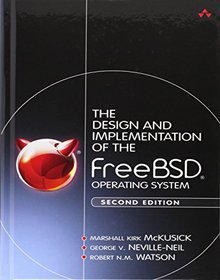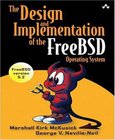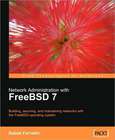The Design and Implementation of the FreeBSD Operating System
2nd Edition

Book Details:
| Publisher: | Addison-Wesley Professional |
| Series: | Addison Wesley , Implementation |
| Author: | Marshall Kirk McKusick |
| Edition: | 2 |
| ISBN-10: | 0321968972 |
| ISBN-13: | 9780321968975 |
| Pages: | 928 |
| Published: | Sep 15 2014 |
| Posted: | Feb 04 2015 |
| Language: | English |
| Book format: | |
| Book size: | 24.31 MB |
Book Description:
The most complete, authoritative technical guide to the FreeBSD kernel's internal structure has now been extensively updated to cover all major improvements between Versions 5 and 11. Approximately one-third of this edition's content is completely new, and another one-third has been extensively rewritten. Three long-time FreeBSD project leaders begin with a concise overview of the FreeBSD kernel's current design and implementation. Next, they cover the FreeBSD kernel from the system-call level downfrom the interface to the kernel to the hardware. Explaining key design decisions, they detail the concepts, data structures, and algorithms used in implementing each significant system facility, including process management, security, virtual memory, the I/O system, filesystems, socket IPC, and networking. This Second Edition Explains highly scalable and lightweight virtualization using FreeBSD jails, and virtual-machine acceleration with Xen and Virtio device paravirtualization Describes new security features such as Capsicum sandboxing and GELI cryptographic disk protection Fully covers NFSv4 and Open Solaris ZFS support Introduces FreeBSD's enhanced volume management and new journaled soft updates Explains DTrace's fine-grained process debugging/profiling Reflects major improvements to networking, wireless, and USB support Readers can use this guide as both a working reference and an in-depth study of a leading contemporary, portable, open source operating system. Technical and sales support professionals will discover both FreeBSD's capabilities and its limitations. Applications developers will learn how to effectively and efficiently interface with it; system administrators will learn how to maintain, tune, and configure it; and systems programmers will learn how to extend, enhance, and interface with it. Marshall Kirk McKusick writes, consults, and teaches classes on UNIX- and BSD-related subjects. While at the University of California, Berkeley, he implemented the 4.2BSD fast filesystem. He was research computer scientist at the Berkeley Computer Systems Research Group (CSRG), overseeing development and release of 4.3BSD and 4.4BSD. He is a FreeBSD Foundation board member and a long-time FreeBSD committer. Twice president of the Usenix Association, he is also a member of ACM, IEEE, and AAAS. George V. Neville-Neil hacks, writes, teaches, and consults on security, networking, and operating systems. A FreeBSD Foundation board member, he served on the FreeBSD Core Team for four years. Since 2004, he has written the 'Kode Vicious' column for Queue and Communications of the ACM. He is vice chair of ACM's Practitioner Board and a member of Usenix Association, ACM, IEEE, and AAAS. Robert N.M. Watson is a University Lecturer in systems, security, and architecture in the Security Research Group at the University of Cambridge Computer Laboratory. He supervises advanced research in computer architecture, compilers, program analysis, operating systems, networking, and security. A FreeBSD Foundation board member, he served on the Core Team for ten years and has been a committer for fifteen years. He is a member of Usenix Association and ACM.
Download Link:
Related Books:
The Design and Implementation of the FreeBSD Operating System
As in earlier Addison-Wesley books on the UNIX-based BSD operating system, Kirk McKusick and George Neville-Neil deliver here the most comprehensive, up-to-date, and authoritative technical information on the internal structure of open source FreeBSD. Readers involved in technical and sales support can learn the capabilities and limitations of the system; applications developers can learn effectively and efficiently how to interface to the system; system administrators can learn how to maintain, tune, and configure the system; and systems programmers can learn how to extend, enhance, and interface to the system. The authors provide a concise overview of FreeBSD's design and implementation. Then, while explaining key design decisions, they detail the...
The Design and Implementation of the 4.4 BSD Operating System
This book describes the design and implementation of the BSD operating system--previously known as the Berkeley version of UNIX. Today, BSD is found in nearly every variant of UNIX, and is widely used for Internet services and firewalls, timesharing, and multiprocessing systems. Readers involved in technical and sales support can learn the capabilities and limitations of the system; applications developers can learn effectively and efficiently how to interface to the system; systems programmers can learn how to maintain, tune, and extend the system. Written from the unique perspective of the system's architects, this book delivers the most comprehensive, up-to-date, and authoritative technical information on the internal structure of the latest BSD s...
Network Administration with FreeBSD 7
Building, securing, and maintaining networks with the FreeBSD operating system
The book is a guide to Network admins who are interested in extracting full potential of FreeBSD. Security-one of everlasting concerns in the IT industry-can be tackled very effectively in FreeBSD. How do you do it? Read the book and find out. You can then move on to learn intricacies of FreeBSD. Just tweak a few parameters to make the network suit your environment. This book is for Network Administrators who would like to work with FreeBSD and are looking for skills beyond installation and configuration of FreeBSD....
2007 - 2021 © eBooks-IT.org



